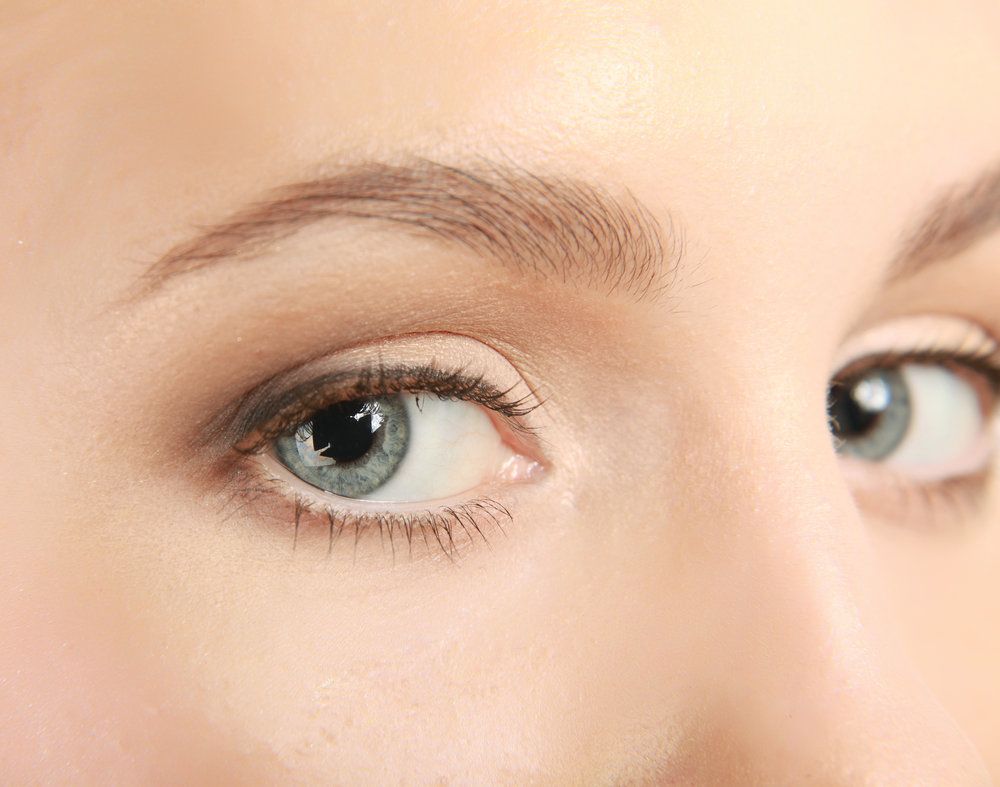Blepharoplasty FAQs Columbus OH
-
1. What is a Blepharoplasty?
-
2. How is the upper eyelid surgery done?
 Prior to the surgery, the patient is placed in an upright position and the natural crease of the upper lid is carefully marked. With the eyes closed, the amount of excess skin is determined by gentle pinching of the loose skin. The excess skin is then marked as an oblong ellipse to be removed. Any excess fat is also marked for removal. Regardless of the type of anesthesia used, local anesthetic is injected into the eyelid skin to reduce bleeding. The skin is excised and bleeding is controlled with an electronic cautery. Sometimes redundant muscle is also removed along with any bulging fat. The skin is then closed with sutures that are normally removed in three to five days. Sterile tapes are also frequently placed over the incisions which should be left in place for several days.
Prior to the surgery, the patient is placed in an upright position and the natural crease of the upper lid is carefully marked. With the eyes closed, the amount of excess skin is determined by gentle pinching of the loose skin. The excess skin is then marked as an oblong ellipse to be removed. Any excess fat is also marked for removal. Regardless of the type of anesthesia used, local anesthetic is injected into the eyelid skin to reduce bleeding. The skin is excised and bleeding is controlled with an electronic cautery. Sometimes redundant muscle is also removed along with any bulging fat. The skin is then closed with sutures that are normally removed in three to five days. Sterile tapes are also frequently placed over the incisions which should be left in place for several days. -
3. How is the lower eyelid surgery done?
There are a variety of ways to do the lower eyelid surgery depending on the patient's wants and need sand the surgeon's preference. The standard lower eyelid Blepharoplasty involves making an incision that starts about one centimeter lateral to the outer corner of the eye extending towards the eye and continuing just below the eyelash line. The skin and muscle that runs around the eye are lifted off of the underlying tissues exposing the three lower lid fat pockets. Excess fat is excised, repositioned or both to reduce or eliminate dark circles and bags. A small amount of excess skin and muscle is then usually removed, much less than what is generally taken out of the upper eyelid. This skin removal is typically quite conservative to avoid the appearance of a wide-eyed stare (scleral show) or eversion of the lower eyelid (ectropion). The eyelid muscle (orbicularis oculi) may be tightened with sutures to provide support to the lower eyelid.
-
4. Is there much pain with eyelid surgery?
Most patients experience stinging and burning pain after eyelid surgery when the local anesthesia wears off. This resolves with oral pain medication which is usually only taken once or twice after surgery.
-
5. What are the scars like after eyelid surgery?
Scarring of human skin is generally directly related to the thickness of the skin. The thicker the skin, the worse the scar. Fortunately, eyelid skin is the thinnest skin on the body, so the scars tend to be very fine and hardly noticeable. The upper lid scar is generally well hidden in the upper eyelid crease and most of the lower lid scar turns into a very fine line below the lash line. The most noticeable scar is from the lower lid incision which extends out into the crows feet where the skin is a little thicker. This typically fades over time to a minimal scar.
-
6. How soon can I wear makeup after a Blepharoplasty?
The sutures are removed in 3-5 days and the incisions are then covered with sterile tapes. It is important to leave the tapes in place for a few days. Most patients are able to wear makeup in about a week.
-
7. How soon can I wear my contacts after eyelid surgery?
After isolated upper lid surgery, most patients are able to wear their contacts within a week to ten days of surgery. It generally takes two to three weeks to wear contacts after lower eyelid surgery. It all depends on swelling and healing which is different in almost every patient.
-
8. What can I do before and after my surgery to speed up my recovery and reduce the risk of complications?
Prior to surgery, you should receive a list of medications to avoid taking for two weeks before surgery to reduce bleeding and bruising. Take this list very seriously. Do not take any medications that contain aspirin within two weeks of surgery. If you have high blood pressure, be sure to take your medication as prescribed and you may want to see your primary care physician to have it checked prior to surgery.
After surgery, it is important to keep your head elevated as much as possible for several days. If you lay flat you will have much more swelling and bruising. A reclining chair with one ore two pillows is a good position. Keep ice packs over your eyes as much as possible to the first 24-36 hours after surgery. Do not bend over or strain for several days after surgery.
-
9. Does insurance ever cover eyelid surgery?
If you have a severe amount of excess upper eyelid skin so that the fold of skin actually obscures part of your vision, it is possible that your insurance company may pay for an upper Blepharoplasty. It would have to be authorized by your insurance company prior to surgery and you would have to have a visual field test from an ophthalmologist to prove that you actually do have a visual field obstruction. Insurance does not pay for lower eyelid surgery.
-
10. Is it possible to have other surgeries done at the same time as a Blepharoplasty?
It is very common to have other surgeries done at the same time as eyelid surgery such as a facelift, brow lift, rhinoplasty, chemical peel or even body contouring procedures such as liposuction, breast implants, breast lifts or a tummy tuck.
-
11. What type of anesthesia is generally used for eyelid surgery?
The answer to this question has a lot to do with the desires of the patient and whether or not it is being combined with other procedures. Most of my patients who are having isolated eyelid surgery prefer to save anesthesia fees and reduce the facility fee by having it done in my office with light oral sedation. Others prefer to be more heavily sedated by intravenous medications while some desire to be ' knocked out' completely with general anesthesia.
-
12. I have already had a Blepharoplasty several years ago and I think that I need another one. Is that possible?
It is possible to have a Blepharoplasty done again. The younger you are when you have your first surgery, the more likely it is that you will consider having another one in the future. In my experience, most patients who have had their upper eyelids done before and are interested in having another one, are more of a candidate for a brow lift than another Blepharoplasty. As the brow drops with age, it contributes to excess skin of the upper eyelids. A brow lift will frequently remove some of the extra skin, raise the brows, make the forehead smoother and reduce the frown lines between the brows. It is much less common to have the lower eyelids done a second time.
-
13. Who is qualified to perform eyelid surgery?
There is no way to get a guarantee of results. You should, however, at least make sure that your surgeon has had adequate training. There are many physicians, some not even surgeons, masquerading as plastic surgeons with very little or no training at all in plastic surgery. Neither the internet nor the phone book care about the truth, honesty, training or credentials. They'll let almost anyone advertise as a plastic surgeon! Make sure your surgeon is certified by the American Board of Plastic Surgery. It is the ONLY legitimate plastic surgery board. It is the only one that evaluates a surgeon's prerequisite training, plastic surgery training, practice performance and requires passage of rigorous written and oral examinations. One way to find out if your surgeon is truly board certified is to see if he or she is a member of the American Society of Plastic Surgeons, Inc. (ASPS). All members of the ASPS are certified by the American Board of Plastic Surgery. Visit their website at www.plasticsurgery.org or call 1-888 4PLASTIC.
I would also recommend that you go one step further. To make sure that your surgeon specializes in aesthetic surgery and, therefore, is not only well trained, but is also very experienced, make sure that he or she is also a member of the American Society for Aesthetic Plastic Surgery (ASAPS). Surgeons that are members of ASAPS are all certified by the American Board of Plastic Surgery, members of ASPS, and have a practice that is dedicated to aesthetic surgery. You can visit their website at www.surgery.org.
Would you let a plumber do the electrical work on your house? Would you have a mechanic do your taxes? How about having an orthopedic surgeon operate on your heart? Then why have an untrained physician, maybe not even a surgeon perform cosmetic surgery on you? If you wind up in someone's office that doesn't have the above credentials, don't walk but run out of that office. And forget the consultation fee. They don't deserve to be paid for trying to deceive you.
Some Ophthalmologists have the training and skill to perform eyelid surgery.
-
14. I had Lasik surgery on my eyes; will that affect my surgery?
Although Lasik surgery will not affect the results of your surgery, it may delay your recovery. Some patients will develop dry eye syndrome after cosmetic eyelid surgery. This is a condition where there is less moisture covering the surface of the eye, so the tear gland (lacrimal gland) produces extra tears to make up for it. The eyes tend to look red and irritated until it resolves. The use of moisturizing and lubricating drops or ointments helps to alleviate the symptoms.
-
15. Will eyelid surgery reduce the wrinkles in my temples near my eyes (crow's feet)?
For the most part, eyelid surgery will not help much with those wrinkles. The most popular treatment for these is Botox Cosmetic injections as well as Dysport and Xeomin Injections.
